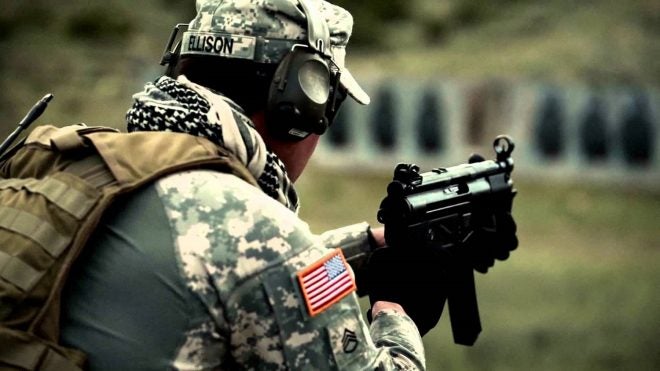In the first part of this series, we looked at the numerous pistol calibre AR-pattern entries and the promising B&T designs submitted to the US Army’s Sub Compact Weapon program. If you missed it you can check it out here.
Attack of the Clones: The MP5s
While most of the designs use a simple blowback action a number of MP5 clones, using HK’s roller-delayed blowback action, have also be selected for testing. Submissions from Zenith Firearms and PTR Industries, Inc. are both copies of the iconic MP5. Zenith’s guns are made on MKE tooling in Turkey, based on the MKEK T94 – built under license from HK. According to the contract award, notice Zenith is submitting three of their MP5 clones: the Z-5RS, Z-5P, and Z-5K with a contract value of $39,060 – the largest of all 13 submissions.
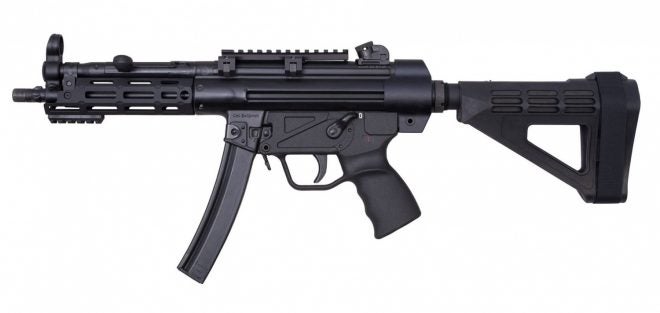
Zenith’s Z-5RS (Zenith)
PTR have submitted the ‘9CS Sub Compact Weapon’, presumably a select-fire version of their 9C guns which were recently introduced at SHOT 2018. PTR, based in Aynor, South Carolina, is perhaps best known for their clones of another HK classic, the G3. Mass production of the 9C only began in January of this year.
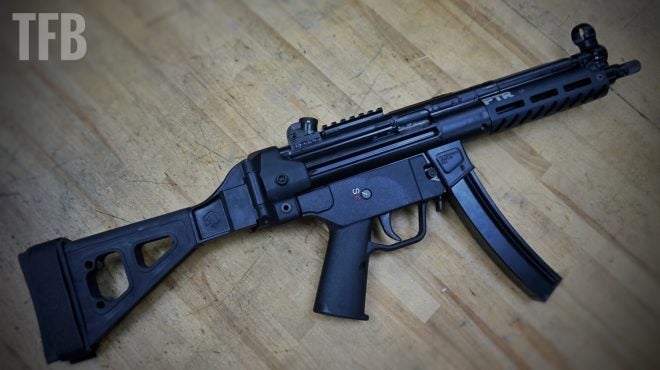
The PTR 9CT with MLOK forend, HK Navy-style pistol grip and side-folding stock (PTR/TFB)
Heckler & Koch themselves, however, have opted to submit their UMP-9 – a standard blowback action gun that fires from a closed bolt. While the MP7, which was purpose designed for the PDW role in the late 1990s, was ruled out by its 4.6x30mm ammunition, the company still manufacture the iconic but arguably obsolescent MP5 and compact MP5K. Instead, they chose to enter the UMP-9, the UMP series was originally designed to augment the MP5 and offer larger calibres such as .45ACP and .40SW, the polymer UMP is almost 0.5 lbs lighter than the MP5. An update to the Army Contracting Command’s contract award notice posted on 16th June shows that HK’s contract is worth $10,850.
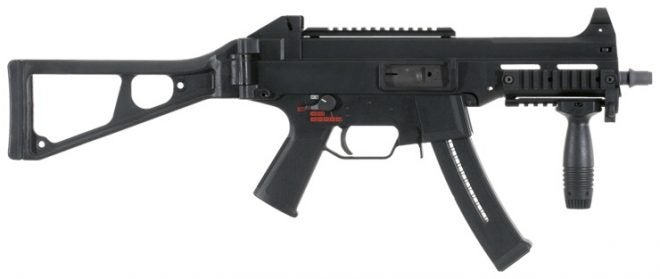
Heckler & Koch UMP9 (HK)
The Prime Contenders
When the RFI was first posted back in May the general consensus in online comments sections was that the popular pistol calibre carbine offerings from CZ and SIG Sauer would be the primary contenders for the SCW contract. SIG Sauer has been awarded a $20,160 contract for evaluation guns while CZ-USA has been awarded $14,490.
The MPX, like the other AR-pattern entries, has controls that will already be familiar to troops trained on the M4 but uses a proprietary lower and magazines. The MPX comes in two variants with the standard variant having a 6.5-inch barrel while the MPX K has a 4.5-inch barrel. Given the award notice’s emphasis on concealability, the MPX K might be SIGs best bet. Weighing 6.2 lbs it has a KeyMod railed forend and a 3 position collapsing stock and a full-length Picatinny top rail.
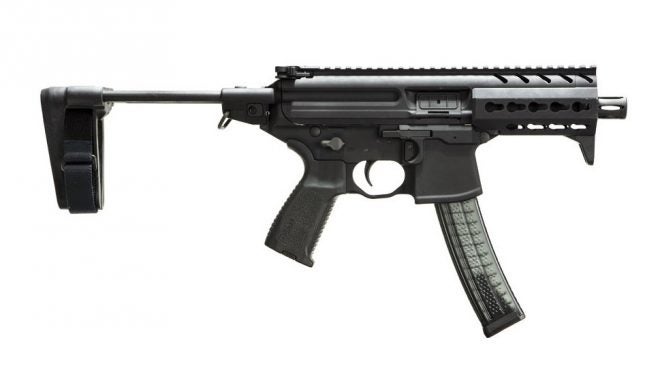
SIG’s MPX K (SIG Sauer)
CZ-USA is submitting the Scorpion EVO 3 A1, a select fire version of their civilian semi-auto S1. The S1 has a 7.7-inch barrel and weighs in at 5 lbs (this, however, is without the Scorpion’s side folding stock). It has an overall length of 26.37 inches with its stock unfolded and weighs 5.95 lbs. CZ also offers the Scorpion EVO 3 S2, a pistol on the civilian market, but a potential compact submachine gun for a military contract like the SCW. The ‘Scorpion-K’ weighs 5.5 lbs and has a collapsed stock overall length of just 16.35 inches.
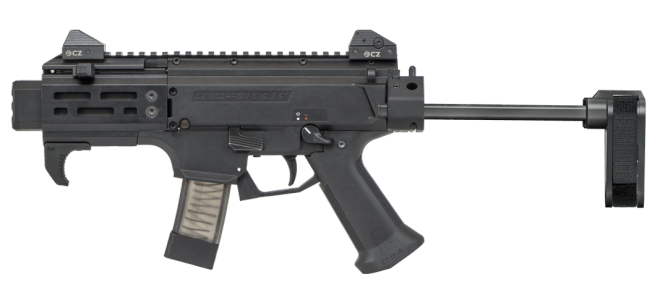
CZ Scorpion EVO 3 Micro (CZ USA)
Both the SIG and CZ have been adopted by law enforcement agencies and militaries around the world, however, the Scorpion appears to have the upper hand with more contract awards won. The MPX is certainly the more expensive option of the two. James recently made a series of videos looking at the pros and cons of the MPX compared to the classic MP5, you can check that out here.
Why Not 5.56 or .300BLK?
In order to answer this question we have to remind ourselves of the information posted with the Army Contracting Command’s SCW special notice, this described the SCW as:
a highly concealable sub compact weapon system capable of engaging threat personnel with a high volume of lethal and accurate fires at close range with minimal collateral damage. An SCW includes but is not limited to functional weapon, magazines, cleaning kits, suppressors, specialized tool kit (if required), spare parts, slings, carrying cases, manuals.
The emphasis here is clearly on concealability and firepower at close range with minimal collateral damage. A compact 5.56x45mm chambered weapon such as a Mk 18 CQBR or SIG’s MCX Rattler are still bulky. Both 5.56 and .300Blk have significantly longer cartridge lengths than 9mm, this necessitates wider, bulkier magazines and a longer action/receiver length. This means that while the weapons are more compact than a standard M4 they are still arguably more difficult to conceal than a pistol calibre submachine gun.
5.56 and .300BLK also produce significantly more muzzle blast and flash in confined spaces, not ideal for operating in vehicles and small rooms. They also have an increased likelihood of causing collateral damage due to the nature of their ballistics, something the SCW program clearly wants to avoid. It seems that on balance of ballistics, logistics and practicality that a 9mm submachine gun is the best option for the SCW.
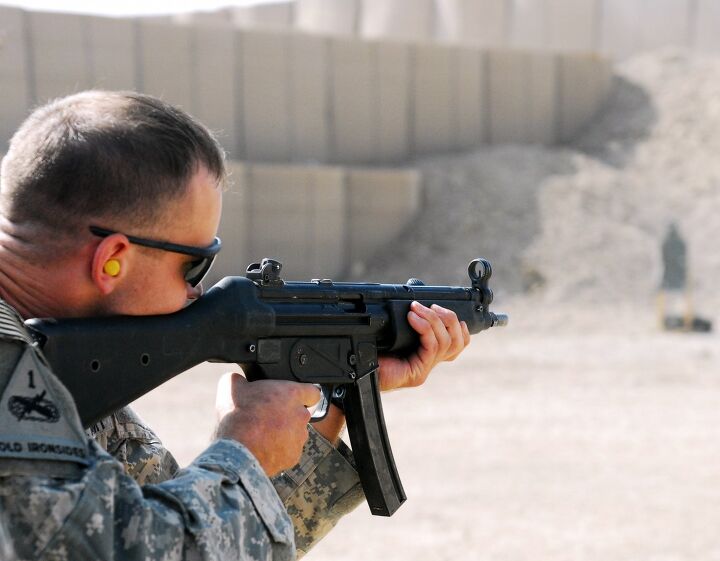
Sgt. Robert Brown fires a MP5 submachine gun at a range on the Iraqi Special Operations Forces compound at Baghdad’s Victory Base Complex Oct. 2009. (Sgt. Lindsey Bradford/US Army)
So What Will Win?
So what will be chosen? That all depends on what the SCW program’s aims are. From the information we have currently it seems that concealability is a primary concern coupled with the ability to lay down a high volume of fire and disengage from a threat – in keeping with Personal Security Detail drills. In terms of a compact, concealable weapon the B&T MP9 seems to be a clear winner but will a weapon that fires at around 1100 rpm be controllable enough for the PSD’s needs? Will a larger weapon like the MPX or UMP make the grade in terms of weight and concealability?
The longer, more bulky entries like the full-size MP5 clones, the Colt, some of the other AR-pattern guns (which lack folding stocks) and the HK UMP seem unlikely to fit the concealable criteria. Until we know more about the SCW program’s requirements and testing criteria we can only speculate which entry might win out. I have contacted Army Contracting Command for further information on the program’s criteria but at this stage they cannot discuss the program. As always cost will be a key factor and compromises will inevitably be made based on unit price, reliability, and fulfillment of the program’s criteria
It is clear that this is not destined to be a general issue weapon. Submachine guns like the SCW will continue to be utilised in niche roles. While the contract may not be for ‘big Army’ it will no doubt be influential, whether the SCW heralds a resurgence for the submachine gun, in general, will remain to be seen and will depend on what is selected.
 Your Privacy Choices
Your Privacy Choices
